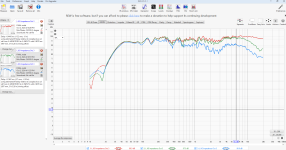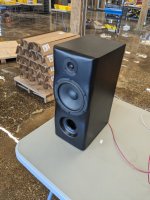3.5ohm (what in my parallel rossover variation psted above is the lowest impendance) is perfectly ok for all amp that can driver a nominal 4ohm speaker. That is already done a million times probally. And yes, you mostly (if not always) need to pad down the tweeter a bit to match the woofer in a crossover or you have a very uneven crossover. Serial crossovers don't avoid that. I think your initial crossover was very uneven, that's why i did my example to show how flat you can get it.
And i did build and restore speakers for over 20 years, most with passive crossover. Never i heared or felt the need to use a serial crossover to rise impendance on the tweeter. I did design and use passive crossovers in the past, but always low order and where it fits the speaker. Here i think a parallel is much better.
And i did build and restore speakers for over 20 years, most with passive crossover. Never i heared or felt the need to use a serial crossover to rise impendance on the tweeter. I did design and use passive crossovers in the past, but always low order and where it fits the speaker. Here i think a parallel is much better.
Clearly, you think I am out to demean you, and this is not the case. I don't know everything, and do occasionally learn something new here. Just because I am older and you are younger does not make you or me inferior. I'm only 46, for what it's worth, and have been doing this heavily since about 2005, and started in 1999. This place is not sparsely populated, nor have I run people off.
As to BSC, if you took farfield data then you likely already have it in use. However, as fluid states in the other thread, the low end simulation looks funny. This means the spectral balance will likely be off. If you used mfr data and applied baffle effects, then BSC is still being applied to the tweeter. BSC is not only for the woofer. Once you rolloff the woofer to account for the BSC, 99x out of 100, you have to pad the tweeter to compensate. I thought a4eaudio put it very succinctly earlier.
As to BSC, if you took farfield data then you likely already have it in use. However, as fluid states in the other thread, the low end simulation looks funny. This means the spectral balance will likely be off. If you used mfr data and applied baffle effects, then BSC is still being applied to the tweeter. BSC is not only for the woofer. Once you rolloff the woofer to account for the BSC, 99x out of 100, you have to pad the tweeter to compensate. I thought a4eaudio put it very succinctly earlier.
I'll admit that a part of me really did want the series to work. Without the series or the fancy baffle this would have been a relatively boring 2 way design.3.5ohm (what in my parallel rossover variation psted above is the lowest impendance) is perfectly ok for all amp that can driver a nominal 4ohm speaker. That is already done a million times probally. And yes, you mostly (if not always) need to pad down the tweeter a bit to match the woofer in a crossover or you have a very uneven crossover. Serial crossovers don't avoid that. I think your initial crossover was very uneven, that's why i did my example to show how flat you can get it.
And i did build and restore speakers for over 20 years, most with passive crossover. Never i heared or felt the need to use a serial crossover to rise impendance on the tweeter. I did design and use passive crossovers in the past, but always low order and where it fits the speaker. Here i think a parallel is much better.
I really did also want to limit my use of resistors since the tweeter and woofer were so well matched. I see how much wattage is wasted to heat when you have to pad down drivers to match. I am unsure if the resistors themselves add any distortion but I imagine adding any components at all adds an amount of distortion. Or so I have read.
It is understandable to want to make something different and not boring, there is a reason why some design elements are repeated more often, because they really do work better in practice.I'll admit that a part of me really did want the series to work. Without the series or the fancy baffle this would have been a relatively boring 2 way design.
Be careful what you read, there is a good deal of nonsense regularly repeated, sometimes by people with no real experience of it themselves. Everything has the potential to have an effect but resistors are one of the most linear passive components if they are of reasonable quality, inductors are the most likely to introduce distortion that is audible. Passive components if used correctly can also reduce distortion from drive units. The frequency balance of a speaker has to be right for it to sound good, if this is wrong nothing else will matter. You won't care about the distortion from a component if the speaker sounds too bright or has no bass.I really did also want to limit my use of resistors since the tweeter and woofer were so well matched. I see how much wattage is wasted to heat when you have to pad down drivers to match. I am unsure if the resistors themselves add any distortion but I imagine adding any components at all adds an amount of distortion. Or so I have read.
Fluid,
Yes, I fully understand that some of what we do is just for fun experimentation. It would be boring if we all just optimized designs and there was no creativity involved. There's a muddy area of creativity and learning and then there is optimal. We'd all build the same thing if we were going for pure optimization.
I imagine its the same with audio as it is with my other hobbies. Bucket loads of repeated bad information just repeated. 10 guys telling you the wrong thing and the guy who knows getting ignored. I suppose that is an internet age issue. Lots of info, no credibility. Whatever happened to the bibliography and source citing?
Yes, I fully understand that some of what we do is just for fun experimentation. It would be boring if we all just optimized designs and there was no creativity involved. There's a muddy area of creativity and learning and then there is optimal. We'd all build the same thing if we were going for pure optimization.
I imagine its the same with audio as it is with my other hobbies. Bucket loads of repeated bad information just repeated. 10 guys telling you the wrong thing and the guy who knows getting ignored. I suppose that is an internet age issue. Lots of info, no credibility. Whatever happened to the bibliography and source citing?
Turns out the vituixcad one was spot on. The off axis is intense. That blue is 90 degrees off axis. This is gated at 80 ms so those ripples are reflections. In an anachoic chamber it would be pretty much flat
Attachments
Lots of energy between 3 and 10 kHz, but that's to be expected with a (non-waveguided) 3/4" tweeter!That blue is 90 degrees off axis.
How do the speakers sound?
By the way for even better readibility you could adjust the display "limits" to 20-20000 Hz and 55-105 dB range!
STV,
They sound very clear. Maybe more clear than my higher end 3 way. It doesn't have that musicality of the low end but that is to be expected. The bass is unexpectedly intense.
We listened to it for about an hour yesterday at the shop. One of my techs said he thinks the builds are beyond his ability to hear now because he thinks it sounds jsut as good as the big 3 way. That was music to my ears because that's what this was supposed to be. It was supposed to be something that your average person would think was as good as it gets while costing very little to make.
They sound very clear. Maybe more clear than my higher end 3 way. It doesn't have that musicality of the low end but that is to be expected. The bass is unexpectedly intense.
We listened to it for about an hour yesterday at the shop. One of my techs said he thinks the builds are beyond his ability to hear now because he thinks it sounds jsut as good as the big 3 way. That was music to my ears because that's what this was supposed to be. It was supposed to be something that your average person would think was as good as it gets while costing very little to make.
- Home
- Loudspeakers
- Multi-Way
- Series Crossover - Sanity Check

